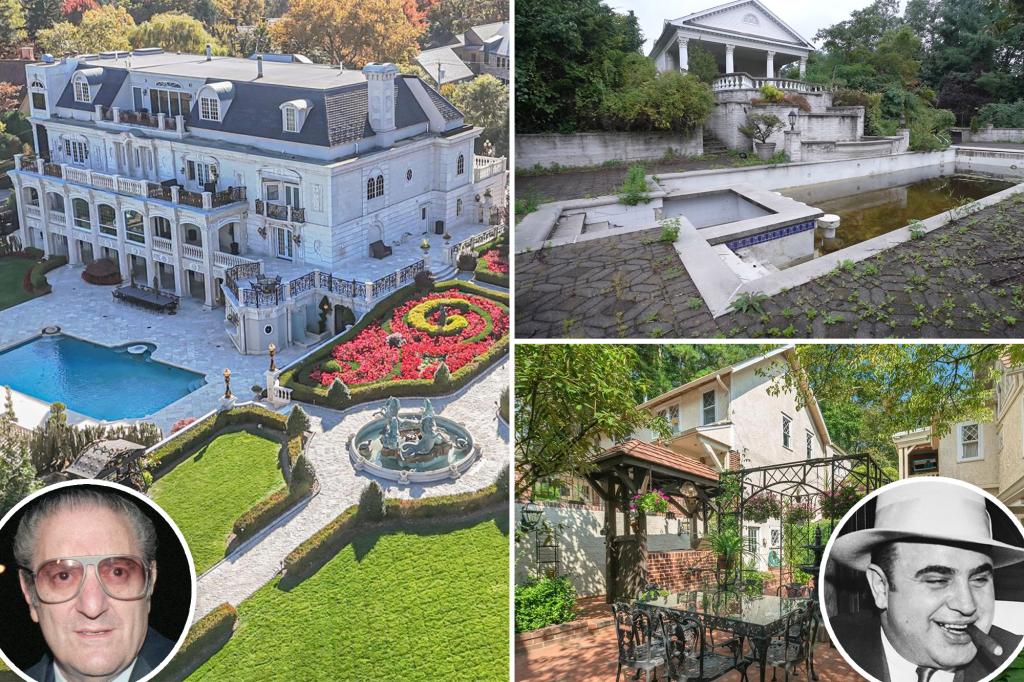I
n the New York metropolitan area, former mob‑era residences are struggling to find buyers. The problem isn’t the criminal history itself but the lavish, idiosyncratic design that makes these homes feel out of place for most modern buyers. Excessive marble, custom layouts, and extravagant finishes create a niche market that few can afford to remodel or appreciate.
Paul “Big Paul” Castellano’s 33,000‑square‑foot estate on 177 Benedict Road in Todt Hill, Staten Island, exemplifies this dilemma. Listed at $18 million—an amount that would have shattered borough sales records—the property boasts Olympic‑sized pools, a 13‑car garage, a home theater, a gym with sauna, a salon, a wine cellar, and a solarium. Its design, intended to echo the White House with a pillared portico and circular drive, has made it difficult to market. Tom Le, who recently sold a $8.5 million home nearby, notes that the marble‑laden interior “makes renovation prohibitively expensive.” The listing has cycled on and off the market since October 2023, and the owner plans to relist after the holidays.
Across the Hudson, Albert Anastasia’s former Fort Lee estate illustrates how even a storied property can be lost to modern land values. Built in the late 1940s, the house passed through owners such as comedian Buddy Hackett and shipping magnate Arthur Imperatore before being subdivided into three lots in 2025. A neighbor’s easement to preserve an unobstructed view of the New York City skyline led to the house’s demolition. The property, once prized for its colorful tiles and wood‑paneled walls, was listed at around $6.5 million from 2022 to 2025 but ultimately sold for $6.1 million before being torn down.
Victoria Gotti’s 6,000‑square‑foot Long Island mansion at 6 Birch Hill Court offers another cautionary tale. After a 2016 federal raid, the estate fell into disrepair, leaving behind chandeliers, designer wardrobes, and a hidden room behind a built‑in bookshelf. First listed in 2013 for $2.5 million, the property lingered on the market for over a decade, finally being foreclosed in 2022. JP Morgan Chase purchased it for $2.65 million, but after multiple price cuts it sold in 2024 for just $1.1 million. Family members, including widow Kim Gotti, expressed disbelief at the final price, recalling the home’s former grandeur.
In Brooklyn, the brownstone at 38 Garfield Place—Al Capone’s childhood home—demonstrates how a historic address can be revitalized. Purchased for $1.85 million in February 2024, developers gutted the interior and rebuilt it with contemporary finishes, including Italian marble and custom millwork. The renovated townhouse, now featuring four to five bedrooms, multiple baths, and expansive windows, was listed at $6.25 million in April 2025 and entered contract in August. The project shows that preserving the façade while modernizing the interior can attract buyers who value history without the burden of outdated features.
Capone’s rumored New Jersey hideout, a Tudor‑style estate in Berlin, New Jersey, also highlights the importance of land value. Known as “The Valley House,” the property was listed at $1.75 million in 2020 but only sold for about $1.3 million in 2020 after two listing cycles. The house’s Prohibition‑era charm—hidden bar, period rooms—was largely eclipsed by the appeal of the surrounding land.
Across these examples, three themes emerge. First, a notorious past alone does not guarantee value; the property’s design and price must align with current market expectations. Second, heavy customization—marble, bespoke layouts—creates a balance‑sheet headache, as buyers face double costs: the original finishes and the expense of removing or updating them. Third, when a property’s scale or style diverges from its neighborhood, the only viable options are deep discounts, extensive renovation, or redevelopment. Fort Lee’s subdivision, Brooklyn’s renovation, and the demolition of Anastasia’s house illustrate these paths.
Ultimately, the legacy of organized crime has faded, but the homes that once housed it remain. To breathe new life into these properties, their past must often be reimagined or erased, allowing modern buyers to see them as contemporary residences rather than relics of a bygone era.














